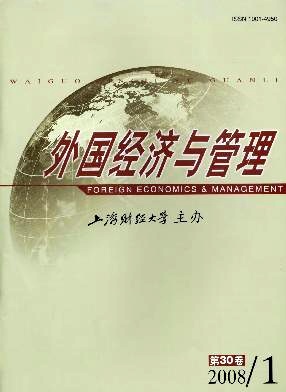组织间关系理论研究的深度与解释力辨析
外国经济与管理 2008 年 第 30 卷第 01 期, 页码:23 - 30
摘要
参考文献
摘要
随着跨组织信息技术、企业全球化经营、产品定制化与市场快速响应机制的发展,组织间关系理论得到了迅猛的发展。组织间关系理论因其独特的研究视角、理论假设、关注焦点和现实启迪而备受关注。本文从组织间关系理论研究的深度与解释力两个方面,对该领域的研究现状进行了深入分析,并提出了我们的观点。
[1]Ronald H Ballou,Stephen M Gilbert,and Ashok Mukherjee.New managerial challenges from supply chain opportunities[J].IndustrialMarketing Management,2000,29(1):7-18.
[2]Wayne E Baker,and Robert R Faulkner.Social networks and loss of capital[J].Social Networks,2004,26(4):91-111.
[3]Mark Frohlich,and Roy Westbrook.Arcs of integration:An international study of supply chain strategies[J].Journal of OperationsManagement,2001,19(2):185-200.
[4]Torstein Nesheim.Externalization of the core:Antecedents of collaborative relationships with suppliers[J].European Journal of Pur-chasing and Supply Management,2001,7(4):217-225.
[5]Frederick E Webster.The changing role of marketing in the corporation[J].Journal of marketing,1992,56(3):1-17.
[6]Jonas Dahlqvist.Knowledge use in business exchange acting and thinking business actors[R].Uppsala University Department of Busi-ness Studies,1998.
[7]Peter L Berger,and Thomas Luckmann.The social construction of reality:A treatise in the sociology of knowledge[M].New York:Anchor Books,1966.
[8]Charles H Fine.Clockspeed:Winning industry control in the age of temporary advantage[M].Massachusetts:Perseus Books,1998.
[9]Ricardo Ernst,and Bardia Kamrad.Evaluation of supply chain structures through modularization and postponement[J].EuropeanJournal of Operation Research,2000,124(3):495-510.
[10]B Joseph Pine.Mass customization:The new frontier in business competition[M].Boston:Harvard Business School Press,1993.
[11]Grover,V,and M K Malhotra.A framework for examining the interface between operations and information systems:Implications forresearch in the new millennium[J].Decision Sciences,1999,30(4):901-920.
[12]Torstein Nesheim.Externalization of the core:Antecedents of collaborative relationships with suppliers[J].European Journal of Pur-chasing&Supply Management,2001,7(4):217-225.
[13]Rebecca Duray,Peter Ward,Glenn Milligan,and Bill Berry.Approaches to mass customization:Configuration and empirical validation[J].Journal of Operations Management,2000,18(6):605-625.
[14]Gra a Amaro,Linda Hendry,and Brian Kingsman.Competitive advantage,customization and a new taxonomy for non make-to-stockcompanies[J].International Journal of Operations and Production Management,1999,19(4):349-371.
[15]Catherine M Ridings,David Gefen,and Bay Arinze.Some antecedents and effects of trust in virtual communities[J].Journal of Strate-gic Information Systems,2002,11(3/4):271-295.
[16]Bart Nooteboom.Institutions and forms of co-ordination in innovation systems[J].Organization Studies,2000,21(5):915-939.
[17]Gee Woo Bock,and Young-Gul Kim.Breaking the myths of rewards:An exploratory study of attitudes about knowledge sharing[J].Information Resources Management Journal,2002,15(2):14-21.
[2]Wayne E Baker,and Robert R Faulkner.Social networks and loss of capital[J].Social Networks,2004,26(4):91-111.
[3]Mark Frohlich,and Roy Westbrook.Arcs of integration:An international study of supply chain strategies[J].Journal of OperationsManagement,2001,19(2):185-200.
[4]Torstein Nesheim.Externalization of the core:Antecedents of collaborative relationships with suppliers[J].European Journal of Pur-chasing and Supply Management,2001,7(4):217-225.
[5]Frederick E Webster.The changing role of marketing in the corporation[J].Journal of marketing,1992,56(3):1-17.
[6]Jonas Dahlqvist.Knowledge use in business exchange acting and thinking business actors[R].Uppsala University Department of Busi-ness Studies,1998.
[7]Peter L Berger,and Thomas Luckmann.The social construction of reality:A treatise in the sociology of knowledge[M].New York:Anchor Books,1966.
[8]Charles H Fine.Clockspeed:Winning industry control in the age of temporary advantage[M].Massachusetts:Perseus Books,1998.
[9]Ricardo Ernst,and Bardia Kamrad.Evaluation of supply chain structures through modularization and postponement[J].EuropeanJournal of Operation Research,2000,124(3):495-510.
[10]B Joseph Pine.Mass customization:The new frontier in business competition[M].Boston:Harvard Business School Press,1993.
[11]Grover,V,and M K Malhotra.A framework for examining the interface between operations and information systems:Implications forresearch in the new millennium[J].Decision Sciences,1999,30(4):901-920.
[12]Torstein Nesheim.Externalization of the core:Antecedents of collaborative relationships with suppliers[J].European Journal of Pur-chasing&Supply Management,2001,7(4):217-225.
[13]Rebecca Duray,Peter Ward,Glenn Milligan,and Bill Berry.Approaches to mass customization:Configuration and empirical validation[J].Journal of Operations Management,2000,18(6):605-625.
[14]Gra a Amaro,Linda Hendry,and Brian Kingsman.Competitive advantage,customization and a new taxonomy for non make-to-stockcompanies[J].International Journal of Operations and Production Management,1999,19(4):349-371.
[15]Catherine M Ridings,David Gefen,and Bay Arinze.Some antecedents and effects of trust in virtual communities[J].Journal of Strate-gic Information Systems,2002,11(3/4):271-295.
[16]Bart Nooteboom.Institutions and forms of co-ordination in innovation systems[J].Organization Studies,2000,21(5):915-939.
[17]Gee Woo Bock,and Young-Gul Kim.Breaking the myths of rewards:An exploratory study of attitudes about knowledge sharing[J].Information Resources Management Journal,2002,15(2):14-21.
引用本文
罗珉. 组织间关系理论研究的深度与解释力辨析[J]. 外国经济与管理, 2008, 30(1): 23–30.
导出参考文献,格式为:
下一篇:产业组织模块化研究前沿探析





 5338
5338  434
434

